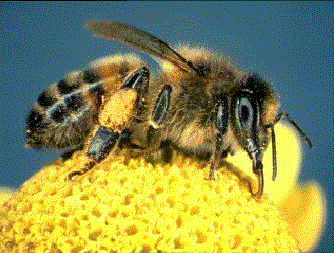Over the past six years, and estimated 10 million beehives have been wiped out as a result of the so-called Colony Collapse Disorder (CCD), causing damage worth $2 billion. It’s difficult to put a price tag on billions of bees, though, or the actual damage their collapse is causing. As you may know, bees pollinate crops, flowers and all sorts of plants are thus indispensable to the global food chain. A study made by scientists at the University of Maryland and the US Department of Agriculture found that, in parts of the US at least, bees are dying in record numbers because of a mix of pesticides and fungicides, contaminating pollen that bees collect to feed their hives.
The researchers collected pollen samples from hives on the US east coast, including cranberry and watermelon crops, and fed these to healthy, unexposed bees. It was found that following ingestion, the whole colony started to collapse making it clear that something in the crops where killing them off. Upon closer inspection, the scientists found that the pollen contained nine different pesticides and fungicides, with one sample of pollen contained as much as 21 types of chemicals. Because of ingestion of this chemical brew, the bees seriously declined in their ability to defend themselves against the parasite that causes Colony Collapse Disorder.
Vulnerable bees
Previously, various causes were attributed to CCD including mites, pesticides and even cell phone towers. Use of pesticides on crops, it seems, is the leading cause of CCD. For instance, after Italy banned several types of pesticides bee populations improved dramatically throughout the country. Most of these pesticides are classed as neonicotinoids, however the present research suggests that the problem is much more complex than previously thought since a whole brew of pesticides and, most importantly, fungicides are at work.
[READ] Crippled bee population might be saved by superbreeding
Previously, it was thought that fungicides are harmless to bees. The current study found that bees that ate pollen with fungicides were three times more likely to be infected by the parasite, so clearly fungicides are a leading cause of CCD. Worth taking into consideration is that the pollen samples came from weeds and wildflowers, and not just crops. This suggests that spraying practices needs to be considered as well, besides pesticide mixtures.
“[M]ore attention must be paid to how honey bees are exposed to pesticides outside of the field in which they are placed. We detected 35 different pesticides in the sampled pollen, and found high fungicide loads. The insecticides esfenvalerate and phosmet were at a concentration higher than their median lethal dose in at least one pollen sample. While fungicides are typically seen as fairly safe for honey bees, we found an increased probability of Nosema infection in bees that consumed pollen with a higher fungicide load. Our results highlight a need for research on sub-lethal effects of fungicides and other chemicals that bees placed in an agricultural setting are exposed to,” write the authors in a paper published in the journal PLOS ONE.
Considering today’s economic climate simply putting a halt to spraying isn’t an option. As such, scientists need to use all the valuable and relevant information they can get pertaining to CCD and establish viable solutions. Maybe an exact group of chemicals can be isolated, banned and then replaced with harmless ones. Are bees running out of time, though? The rate of bee decline is accelerating, indeed, but hopefully with diligence and proven methods we might avert a global catastrophe.










